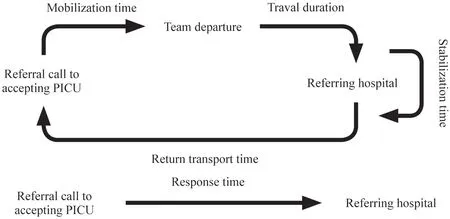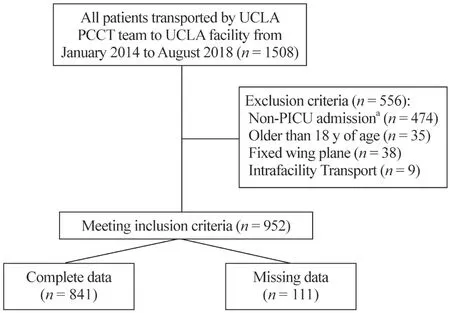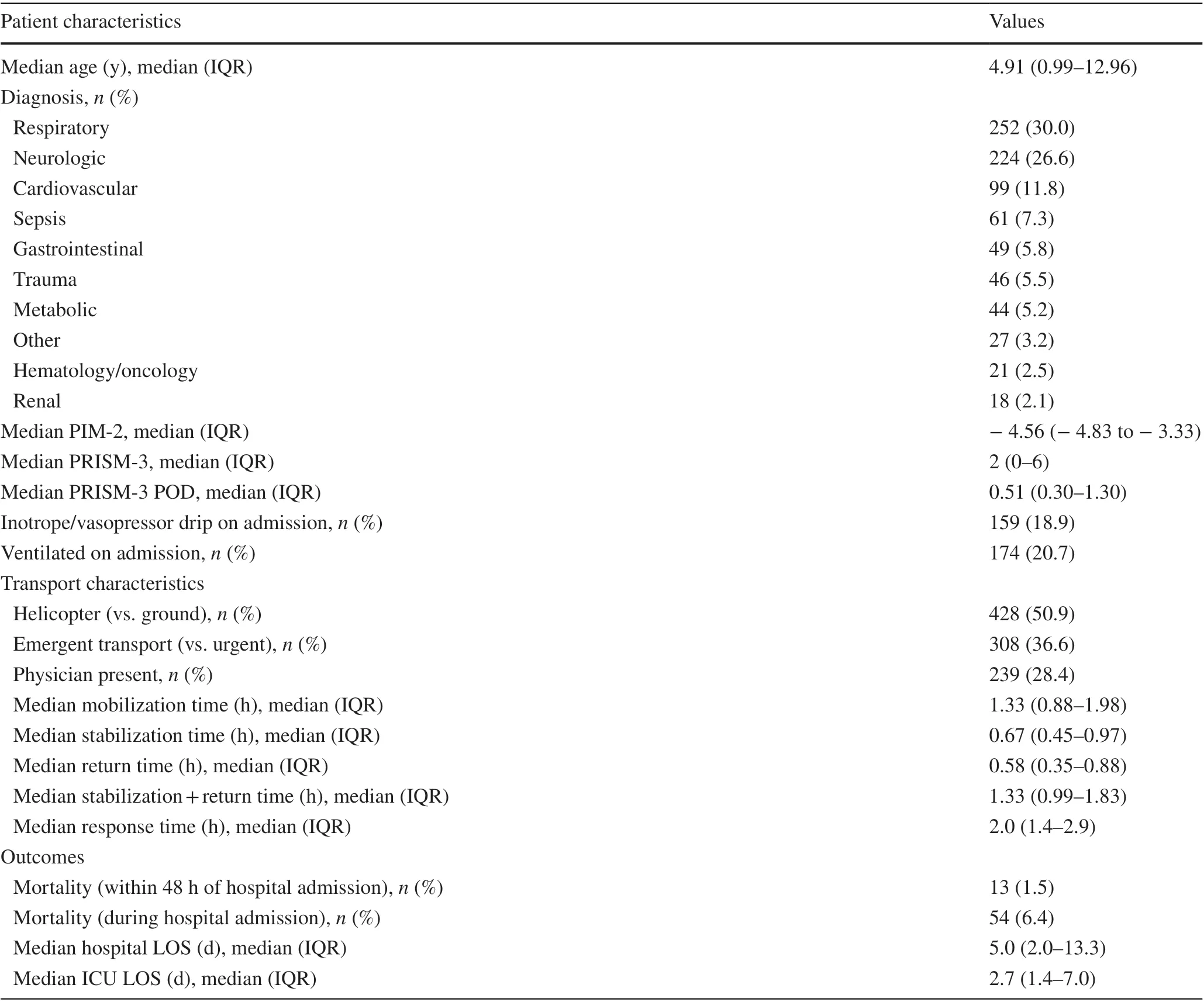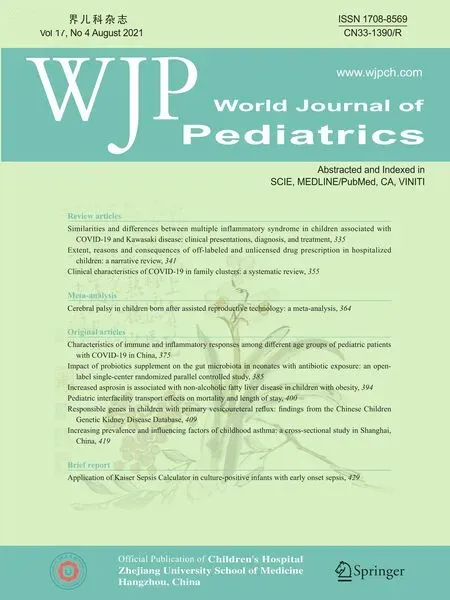Pediatric interfacility transport effects on mortality and length of stay
Rod M. Shinozaki 1 · Andreas Schwingshackl 1 · Neeraj Srivastava 1 · Tristan Grogan 1 · Robert B. Kelly
Abstract
Keywords Helicopter · Hospital length of stay · Pediatric critical care · Pediatric intensive care unit · Transport medicine
Introduction
Currently, no evidence-based pediatric guidelines exist that define the requirement for physician presence on interfacility transports, the ideal mode of transportation, or limitations of mobilization and travel times to and from outside facilities due, in part, to the paucity of studies in this field[ 1- 4]. However, several reports suggest that the outcomes of children improve when they are transported by specialty pediatric transport teams rather than basic emergency medical services [ 5- 7], as evidenced by improved mortality rates and decreased frequency of adverse events during transport [ 6, 8- 10]. Non-physician transport team members have shown strong potential in providing procedural interventions, such as high successful intubation rates of 95-100%[ 11, 12]. One study comparing respiratory therapists to resident physicians on a transport team showed higher success rates for endotracheal intubation among respiratory therapists (92% vs. 77%) [ 13]. To date, only one study has compared specialty pediatric transport teams with and without a physician, and no differences in mortality were seen when adjusted for the severity of illness of the transported patients [ 12].
Furthermore, when comparing air versus ground transports,studies have suggested that helicopters are faster at transporting patients than ambulances [ 14] and are associated with improved survival in adult [ 15] and pediatric trauma patients [ 16- 18].Only one adult study showed that transport time intervals are independently associated with intensive care unit (ICU) length of stay (ILOS) and hospital length of stay (HLOS) [ 19], and one neonatal study on premature infants showed that faster response times were not associated with improved outcomes [ 20].
Our aim was to investigate whether an association exists between (1) interfacility response time; (2) mode of transport; and (3) physician presence during the transport of critically ill children and clinically relevant outcomes, including(1) mortality; (2) ILOS; and (3) HLOS. We hypothesized that a shorter response time and helicopter transports, but not physician presence, are associated with lower mortality and a shorter LOS after adjusting for relevant risk factors.
Methods
Setting
The UCLA Mattel Children’s Hospital pediatric ICU (PICU)is a 24-bed quaternary unit affiliated with the University of California, Los Angeles, which also cares for post-operative cardiovascular surgical patients. Our pediatric critical care transport (PCCT) team includes, at a minimum, a respiratory therapist and a pediatric critical care nurse. Only if the PICU team deems it necessary given the patient’s perceived clinical condition will the on-call (home or in-house) physician be activated. The physician team includes PICU and neonatal ICU (NICU) attendings, pediatric critical care and neonatal-perinatal medicine fellows, and emergency medicine resident physicians. Respiratory therapists are required to have a number of competencies within the adult ICU, PICU,NICU, and emergency department. All members complete air flight safety classes and equipment workshops. Our PCCT team nurses are highly trained with a minimum of 3 years of experience as bedside PICU and/or NICU nurses before being trained to go on transports. PCCT team physicians are not required to be on site at all times, but available within 30 minutes. The PCCT team’s intake area extends throughout California and Nevada, but most transported patients are within a heavily trafficked metropolitan region.Each year the PCCT team performs an average of over 350 pediatric and neonatal critical care transports by ground and air. REACH Air Medical Services (Santa Rosa, CA) is the preferred helicopter provider for UCLA Mattel Children’s Hospital, but our own UCLA PCCT team members accompany REACH crewmembers as the primary care providers.
Data collection
The UCLA Institutional Review Board approved this study and waived informed consent. A chart review of all PCCTs between January 2014 and August 2018 was performed. A patient met inclusion criteria if they were transported by our PCCT team to the PICU at UCLA and were 18 years of age or younger. Exclusion criteria included patients who were not transported to the PICU at UCLA, were transported by fixedwing aircraft, were patients greater than 18 years of age, or were intra-facility transports. Original data variables of age,diagnosis, mode of transport, physician presence during transport, and transport team departure time were obtained from the UCLA Mattel Children’s Hospital’s transport database.These data elements are entered by the critical care transport nurse after each transport. We defined the following transport time intervals as: mobilization time = time from referral call to team departure; travel duration = time from accepting hospital to the referring hospital; response time = mobilization time + travel duration; stabilization time = time spent preparing the patient to leave; return transport time = time spent traveling back (Fig. 1). Through UCLA’s Clinical and Translational Science Institute’s informatics program, we reviewed each patient’s electronic health record to extract informationon inotrope, vasopressor, and mechanical ventilation requirements on admission. Registry Partners (Burlington, NC), an independent data extraction group contracted with UCLA, provided pediatric index of mortality-2 (PIM-2) [ 21], pediatric risk of mortality-3 (PRISM-3) [ 22], and PRISM-3 probability of death (POD) [ 23] scores for each transported patient admitted to the PICU. To provide consistency, a single investigator(RMS) coordinated or performed all data abstraction.

Fig. 1 Depiction of a typical interfacility transport and associated time intervals. PICU pediatric intensive care unit
Statistical methods
Patient characteristics and study variables were summarized using the medians [interquartile range (IQR)] for continuous variables or frequency (%) for categorical variables. We compared patient, transport, and outcome variables between physician presence and mode of transportation using the Chi-square test or Student’sttest, as appropriate. Finally, to determine if physician presence,response time, or air transport were associated with our predefined study outcomes (mortality, ILOS, and HLOS)after adjusting for patient morbidity (PIM-2 and PRISM-3 scores) and other patient characteristics, we ran multivariable logistic or linear regression models. To assess outcomes (mortality, ILOS, and HLOS) between diagnostic categories, we used trauma patients as the referent category, since this group was moderately sized and had the lowest LOS of all 10 diagnostic groups. We ran complete case analyses for these models, and seven patients were excluded due to missing stabilization and/or return times.These seven patients did not appear characteristically different than the other patients, therefore the assumption of these to be missing completely at random seemed reasonable, and we proceeded with the analyses. From the models, we extracted the relevant odds ratios with 95%confidence intervals (CIs) or effect sizes with 95% CIs.A propensity score modeling approach was also run as a sensitivity analysis for physician presence and air versus ground transports. Statistical analyses were performed using SPSS V25 (IBM Corp., Armonk, NY) or R V3.5.1( www.r- proje ct. org, Vienna, Austria).Pvalues < 0.05 were considered statistically significant. Standard mortality ratios (SMR) were calculated by observed mortality within our ICU divided by expected mortality from PRISM-3 POD.
Results

Fig. 2 Depiction of study population analyzed. PCCT pediatric critical care transport, PICU pediatric intensive care unit, NICU neonatal intensive care unit. a NICU, inpatient wards, step-down off-site PICU,emergency room
Between January 2014 and August 2018, 1508 pediatric patients were transported to UCLA by our PCCT team.After excluding 556 patients due to non-PICU transports,fixed-wing transports, transports of patients greater than 18 years of age, and intra-facility transports, 952 patients met inclusion criteria. However, due to missing data points,ultimately 841 patient transports were analyzed (Fig. 2).The median age of the transported PICU patients was 4.91(IQR 0.99-12.96) years. The most common diagnoses were categorized as respiratory (252, 30.0%), neurological(224, 26.6%), and cardiovascular (99, 11.8%). The median PIM-2 score was - 4.56 (IQR - 4.83 to 3.33), and the median PRISM-3 score was 2 (IQR 0-6). On admission, 159 (18.9%)patients were receiving inotrope or vasopressor infusions,and 174 (20.7%) patients were mechanically ventilated. Helicopter transports were utilized for 428 (50.9%) patients, and ambulance transports were utilized for 413 (49.1%). Physicians were present on 239 (28.4%) transports. The median response time was 2.0 (IQR 1.4-2.9) hours, and the median stabilization time was 0.67 (IQR 0.45-0.97) hours. The allcause mortality rate during the first 48 hours after admission was 1.5% (13 patients) and 6.4% (54 patients) during hospitalization. The overall SMR was 1.64. If a physician was present on the transport, the SMR was 1.60, compared to 1.73 when a physician was not present (P= 0.812). The SMR for helicopter transports was 1.77 compared to 1.44 for ground transports (P= 0.369). The median ILOS was 2.7 (IQR 1.4-7.0) days, and the median HLOS was 5.0 (IQR 2.0-13.3) days (Table 1).
Univariate analysis revealed that physician presence and helicopter transports were both significantly associated with worse PIM-2 and PRISM-3 scores (Tables 2 and 3). The median response time when physicians were present was 2.18 hours compared to 1.92 hours when no physician was present, resulting in a difference of 0.26 hours (P= 0.020). However, physician presence and response time were not significantly associated with our outcomes of interest (mortality, ILOS and HLOS) when adjusting for age, diagnosis, mode of transport, responsetime, stabilization time, return duration, mortality risk(PIM-2 and PRISM-3), and inotrope, vasopressor or mechanical ventilation presence on admission (Table 4).Compared to ground transports, helicopter transports resulted in an average increase in HLOS of 3.24 (95%CI 0.59-5.90;P= 0.017) days, but not in ILOS (average 1.68 days; 95% CI - 0.11 to 3.47;P= 0.066). As a sensitivity analysis, we elected to perform a propensity score matched analysis with the same variables to confirm our multivariable model estimates for both the effect of physician presence and helicopter transports on our three outcomes of interest (mortality, ILOS, and HLOS). In general, the multivariable and propensity score models produced similar estimates andPvalues(results not shown).

Table 1 Summary of demographics and outcomes ( n = 841)
Discussion
Our analysis of 841 pediatric patients revealed that neither physician presence nor response time was significantly associated with mortality, ILOS, or HLOS. We did find that helicopter transports were not significantly associated with mortality or ILOS, but were associated with a longer HLOS. In our retrospective cohort study, we used data from our PCCT team database and electronic medical record to study transport characteristics among a critically ill pediatric patient population with a diverse set of diagnoses. This is the first study to comprehensively investigate the effects of transport team response time, physician presence during transport, and mode of transportation on mortality and LOS among a critically ill pediatric cohort.

Table 2 Comparison between physician presence and patient characteristics
Our mortality results are consistent with a study by Sharpe et al. [ 20] who also found no difference in mortality when adjusting for response time, but this study only analyzed 105 infants less than 29 weeks gestation. Belway et al. [ 19] found that mortality among adult cardiac patients was not associated with various transport time intervals,but longer response times were associated with a shorter HLOS. The authors speculated that their findings were due to the referring hospital’s ability to stabilize patients before being transported to the specialized unit. These findings are consistent with data from UC Davis Children’s Hospital showing the quality of pre-transport clinical care and close communication with the outside hospital before the PCCT team’s arrival can help improve illness severity scores on admission [ 24]. We speculate that the effects of prolonged transport times can be mitigated by continued improvements in prehospital care and practice guideline development as well as close communication between accepting and referring hospitals. Some patients, however, may simply need expeditious transport to an accepting hospital for definitive care despite stabilization attempts at a referring hospital or close communication between the referring hospital and the accepting hospital. Given the heterogeneity of our patient cohort in terms of diagnoses, we speculated that certain diagnoses, such as trauma, may be more sensitive to prolonged transport times. To investigate thesepotential outcome differences between patient subgroups,we attempted a subgroup analysis based on diagnosis, but we could not achieve adequate power.

Table 3 Comparison between mode of transport and patient characteristics
Herrup et al. [ 25] surveyed several transport programs and revealed substantial heterogeneity in the subspecialty training level of transport physicians (PICU fellows, neonatology fellows, pediatric emergency fellows, or pediatric anesthesiology fellows) and the years of experience and requirements before joining the team. A survey among transport team members by McCloskey et al. [ 26] concluded that 46% of respondents felt that a physician was needed to transport critically ill patients. A registry is likely required to track team composition and level of training along with outcomes before any broad conclusions can be made beyond our center. The high level of competency of our PCCT team nurse and respiratory therapist may be the reason for the lack of effect of physician presence on transport. Similar to the physician’s level of training, a formal analysis of the competency of all other transport team members may reveal strategies to further improve safety, outcomes, and cost of high acuity pediatric transports.
Our study did not show a lower mortality or reduced ILOS with helicopter transports. We suspect that pretransport stabilization, small diagnostic sample sizes, and an overall shorter total transport time relative to a patient’s overall ILOS likely explain these findings. Delgado et al.[ 27] showed that for helicopter transports to be cost-effective they would need a relative risk reduction in mortality of 15% compared to ground transport when utilizing the costeffectiveness ratio of less than $100,000 per quality-adjusted life-year gained. Taylor et al. [ 28] reviewed studies showing helicopter transport programs commonly lack cost-effectiveness. There are no widely used algorithms to determine the indicated or recommended modality of transport among PCCT teams. Transport programs deal with varying local traffic conditions, weather patterns, and team resource limitations, all of which can affect the decision-making process.

Table 4 Multivariate analyses of the association between transport variables and outcomes
Lastly, we speculate that the significant increase in HLOS for helicopter transports compared to ground transports may be due to limitations in vital sign monitoring,altitude and vibration effects, crew resource management during flight, space limitations, and conservative discharge criteria due to potentially long distances for necessary follow-up appointments. These factors are likely minor confounders, thereby less likely to affect ILOS or mortality to the same extent. Without a larger, multi-center study, we caution against using these results to limit this expensive mode of transport among pediatric patients requiring interfacility transport.
Our study has a number of strengths. First, we utilized two standard and commonly calculated illness severity scores, PIM-2, and PRISM-3, while also adjusting for inotrope, vasopressor, and mechanical ventilation use along with various transport time intervals. Second, the heterogeneity of diagnoses and degree of disease severity among our patients allowed us to study a unique population likely to be at the highest risk during interfacility transport. Third,our high rate of helicopter transports due to our hospital’s geographical location, referral base, and traffic congestion allows us to speculate on how helicopter transports can impact medical outcomes. Lastly, we applied multivariate analyses and propensity score modeling as a sensitivity analysis to demonstrate the feasibility of such a study. Conducting a randomized controlled trial evaluating physician presence, mode of transportation, and response time would be challenging and perhaps impossible to conduct ethically or with equipoise.
There are several limitations to our study. Our study may be underpowered to detect a clinically meaningful difference in mortality given that the all-cause mortality during hospitalization was 6.4%. Furthermore, 11.6% of our patients were excluded due to missing data points.Although we attempted to account for confounders by performing multivariate logistic and linear regression analyses as well as propensity score matching, it is possible that we still missed additional confounding effects[ 29]. We attempted to control for illness severity utilizing PIM-2 and PRISM-3 scores, which, to our knowledge, has not been done in pediatric interfacility transport research. We recognize that PRISM-3 may be an inaccurate reflection of transport illness severity since the score is calculated from data obtained during the first 12 hours of admission. The score could, therefore, be influenced by therapies administered during that time [ 30]. Future studies utilizing PRISM-4 scores may be more reflective considering this score is calculated using a data range spanning from two hours before admission to four hours after admission [ 22].In conclusion, our analysis of 841 pediatric patients revealed that neither physician presence nor response time was significantly associated with mortality, ILOS or HLOS. We did find that helicopter transports were not significantly associated with mortality or ILOS, but were associated with a longer HLOS. Despite the limitations of a single-center study, our analysis provides a framework for examining transport workforce needs and helps guide further studies using large PCCT databases to further characterize the impact of time intervals, mode of transport,and physician presence.
Author contributionsRMS contributed to data curation, investigation,methodology, writing of original draft, review and editing. AS and NS contributed to methodology, review and editing. TG contributed to formal analysis, funding acquisition, methodology, software, review and editing. RBK contributed to conceptualization, investigation, methodology, project administration, supervision, review and editing. All the authors approved the final version of the manuscript to be published.
FundingStatistical analysis by TG was funded by NIH National Center for Advancing Translational Science (UCLA CTSI grant number:UL1TR001881). The NIH had no role in the design and conduct of the study.
Compliance with ethical standards
Ethical approvalThe UCLA Institutional Review Board approved this study and waived informed consent (#18-001707).
Conflict of interestNo financial or non-financial benefits have been received or will be received from any party related directly or indirectly to the subject of this article. The authors have no conflict of interest to declare.Data availabilityThe datasets generated during and/or analyzed during the current study are not publicly available due to individual privacy, but are available from the corresponding author upon reasonable request.
Open AccessThis article is licensed under a Creative Commons Attribution 4.0 International License, which permits use, sharing, adaptation, distribution and reproduction in any medium or format, as long as you give appropriate credit to the original author(s) and the source,provide a link to the Creative Commons licence, and indicate if changes were made. The images or other third party material in this article are included in the article’s Creative Commons licence, unless indicated otherwise in a credit line to the material. If material is not included in the article’s Creative Commons licence and your intended use is not permitted by statutory regulation or exceeds the permitted use, you will need to obtain permission directly from the copyright holder. To view a copy of this licence, visit http:// creat iveco mmons. org/ licen ses/ by/4. 0/.
 World Journal of Pediatrics2021年4期
World Journal of Pediatrics2021年4期
- World Journal of Pediatrics的其它文章
- Increased asprosin is associated with non-alcoholic fatty liver disease in children with obesity
- Mosaic trisomy 12 diagnosed in a female patient: clinical features,genetic analysis, and review of the literature
- Increasing prevalence and influencing factors of childhood asthma:a cross-sectional study in Shanghai, China
- Responsible genes in children with primary vesicoureteral reflux:findings from the Chinese Children Genetic Kidney Disease Database
- Impact of probiotics supplement on the gut microbiota in neonates with antibiotic exposure:an open-label single-center randomized parallel controlled study
- Characteristics of immune and inflammatory responses among different age groups of pediatric patients with COVID-19 in China
